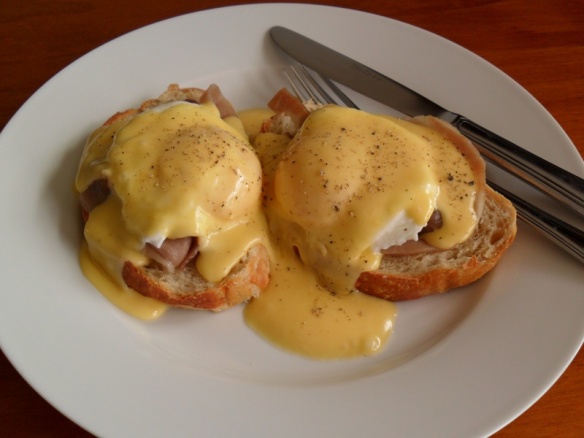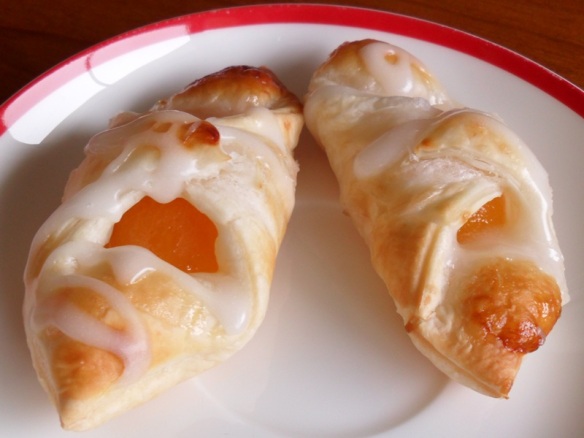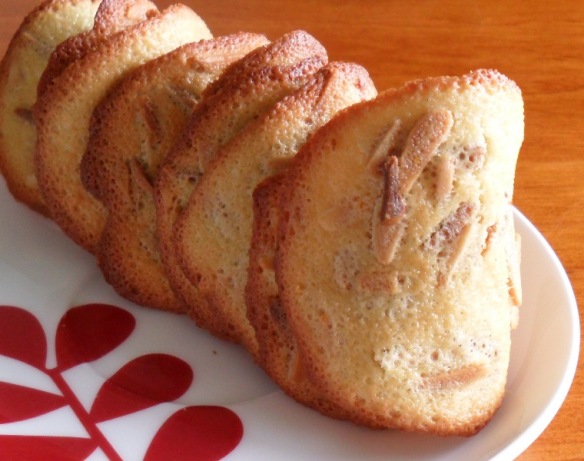Time saver: as close as you can get to drinking pure butter without actually drinking pure butter.
I’ve been a bit unsure about this post. Hollandaise sauce can be made in a variety of different ways, some more involved than others, and even the ratios seem to vary a bit. All I can do is tell you how I would go about making it if I was cooking. Your mileage may vary.
You can drizzle it over asparagus if you want to, but my favourite is eggs benedict with hollandaise liberally poured over the top.
 As previously mentioned, the recipes vary a bit. Some will have you reduce vinegar before adding it to the egg yolks, others get you to make the entire thing in the blender. I like the zingy flavour of lemons, so use quite a lot of lemon juice, you may prefer to use half as much (1 Tbsp instead of 2). I also like the flavour of vinegar in it, so sometimes add ½-1 tsp just near the end. You can do the same, leave it out, or try reducing it first (which should take some of the sharpness off it, though you’ll need to start with a couple of tablespoons of it). Using less butter will give you a thicker sauce, using more gives you more sauce at the end. For two servings of eggs benedict (for a total of 4 eggs) I’d use around 75g butter just to be sure I had enough.
As previously mentioned, the recipes vary a bit. Some will have you reduce vinegar before adding it to the egg yolks, others get you to make the entire thing in the blender. I like the zingy flavour of lemons, so use quite a lot of lemon juice, you may prefer to use half as much (1 Tbsp instead of 2). I also like the flavour of vinegar in it, so sometimes add ½-1 tsp just near the end. You can do the same, leave it out, or try reducing it first (which should take some of the sharpness off it, though you’ll need to start with a couple of tablespoons of it). Using less butter will give you a thicker sauce, using more gives you more sauce at the end. For two servings of eggs benedict (for a total of 4 eggs) I’d use around 75g butter just to be sure I had enough.
Hollandaise sauce
- 1 egg yolk
- 50-100g butter
- 1-2 Tbsp lemon juice (to taste)
- white wine vinegar (to taste)
- Cut the butter into small cubes and leave to soften (if in a hurry you can soften in the microwave).
- Set up a double-boiler (put a couple of cms of water in the bottom of a saucepan, then sit a stainless steel bowl on top, big enough that the bottom of it is above the water level) and set over a low heat.
- Put the egg yolk and lemon juice in the top of the double-boiler and whisk together. Continue whisking as the double-boiler continues to heat. (Watch it closely and be careful not to completely cook the egg yolk or you’ll have to start again.)
- Eventually the mixture should start to thicken, at this point remove the double-boiler from the heat, and start adding the cubes of butter, whisking to combine. Continue until all the butter has been added.
- Taste the sauce and add more lemon juice or a little white wine vinegar for flavour. Then serve. (You could add cracked black pepper to the sauce, I normally just crack it over the sauce once served.)
- EMERGENCIES ONLY: hollandaise sauce is an emulsion, and emulsions sometimes separate. The key to getting it back together is simple: if the sauce is hot, add cold water a drop at a time and whisk thoroughly until recombined. If the sauce is cold, add hot water a drop at a time and whisk thoroughly until recombined.







